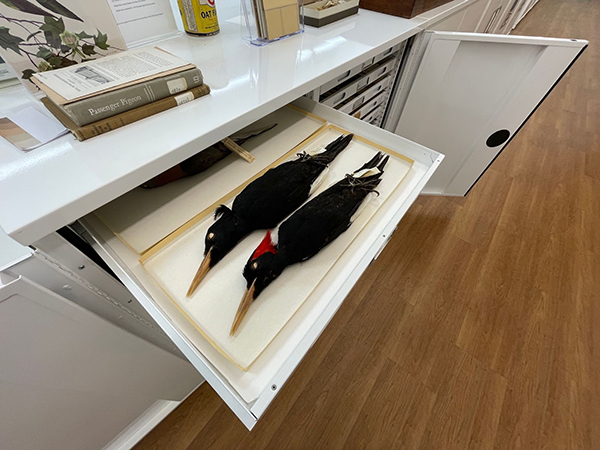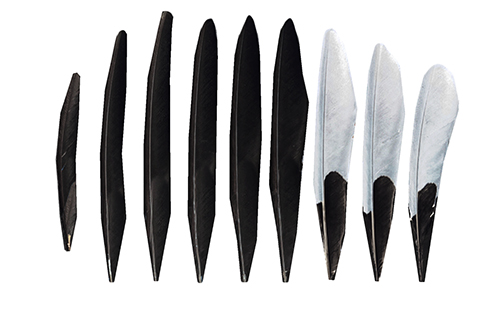In 1956, William Rhein, a dentist with a passion for birds, ventured deep into the mountains of Durango, Mexico.
Balancing a 16mm handheld color camera on the back of a mule, he managed to capture a fleeting record of the world’s largest woodpecker. Towering at nearly two feet tall, the Imperial Woodpecker (Campephilus imperialis) was already disappearing due to deforestation and human encroachment. Rhein’s footage would become the last, and only, visual trace of this majestic species while it was alive. Now, decades later, a collaboration between the Moore Laboratory of Zoology at Occidental College and the Digital Life Project brings the Imperial Woodpecker back to life—in the digital realm. Using 3D photogrammetry and digital artistry that references specimens, taxidermy, and the Rhein film, we have produced two moving models of an Imperial Woodpecker. Read on to learn about how we created these models and what we hope our work inspires.
The main problem with modeling a bird in 3D is … all those feathers. Enter CG artist Johnson Martin and UMass Amherst PhD student Josh Medina. For Josh, it was the feathers that had originally drawn him to the Moore Lab as an undergrad at Occidental College. As a Classics major with an interest in 3D modeling, Josh was taken with the beauty—and the challenge—of modeling bird specimens. A few years of tinkering led to a method and a National Science Foundation fellowship to carry his interests forward as a PhD student in Duncan Irschick’s lab. There, the Digital Life Project was already working to bring static 3D models to life, with the help of CG artists like Johnson Martin. The work would involve more than just feathers. Their aim was nothing less than to create the only open-access 3D bird model with accurate feathers, morphology, and locomotion for research, education, and inspiration.
To begin, Josh and Johnson started with a 3D scan of a female Imperial Woodpecker from the Moore Laboratory of Zoology collection (MLZ:Bird 20609), on a version of the rig that Josh had set up as an undergrad. Russell Campbell, who by that time was leading the 3D Birds project at Occidental, took a scan of a female specimen, collected by Chester Lamb in Durango, Mexico in 1938, one of the last individuals to ever be collected for science and not too far away from where Rhein encountered the species in 1956. The 3D team also referred to taxidermied models to understand how the plumage patterns looked in a lifelike pose. For instance, the stripes on the outside of the mantle (back feathers) could vary from almost invisible on some scientific specimens to very prominent in certain taxidermied models and illustrations.
From there, Josh and Johnson built the bird almost feather by feather. The foundation of the body was taken from the 3D scan and extended to display the full wingspan, since the wings of most specimens cannot be opened. The bird’s contour and covert feathers were created digitally and placed individually across the body and wings. The primary and secondary feathers of each wing were also designed individually and placed with reference to taxidermy and existing artist renderings.
To our knowledge, this is the most realistic, open-access 3D model of a bird that exists. Researchers can use the model to study avian anatomy in fine detail without needing to obtain rare physical specimens.
Once the details of structure and plumage were established, Josh and Johnson had to make the model move. A 3D “skeleton” with controls was created and connected to the model in a 3D modeling program called Blender, which made it easy to move the bird's body, and even each wing feather, individually. Next, the tedious task of animating the bird began using keyframed animation, where key positions in a movement are captured while the intermediate action is filled in automatically, creating smooth motion.
What are the uses of a model like this? To our knowledge, this is the most realistic, open-access 3D model of a bird that exists. Researchers can use the model to study avian anatomy in fine detail without needing to obtain rare physical specimens. Educators can incorporate it into virtual classrooms, allowing students to explore bird morphology and locomotion interactively.
Additionally, the model can be used for public outreach, enhancing museum exhibits. Its accessibility also means that international institutions in developing parts of the world can benefit from cutting-edge resources, democratizing access to scientific tools and specimens. This model can also serve as a basis for future, even more biologically realistic 3D bird models.
Perhaps most of all, we hope our work inspires the public. The fleeting glimpses of the Imperial Woodpecker in William Rhein’s film made us ache for a closer and longer look. By creating a lifelike, 3D model, we hope to provide that opportunity—a chance to linger over the beauty and details of a majestic species lost to time. We hope it serves as a powerful reminder of what we stand to lose if conservation efforts falter, urging future generations to take action and turn loss into motivation for protecting the biodiversity we still have.
To that end, the Moore Lab of Zoology, with Mexican collaborators, are working on the final stages of a retrospective study of changes to Mexican bird diversity over the last 100 years. By comparing museum specimen data to modern observations, our work will provide a country-wide perspective on how birds have been impacted by 100 years of human-caused change to the landscape.
This work was carried out through a collaboration between the Moore Laboratory of Zoology at Occidental College (PI: John McCormack) and the Digital Life Project based at UMass-Amherst (PI: Duncan Irschick). Josh Medina and Johnson Martin created the 3D model. The project was funded as part of the broader impacts of NSF CAREER grant DEB-1652979 to John McCormack. Thanks to Jenny Wong, Noah Medina, Russell Campbell, Vicente Rodriguez (CONABIO), and Diego Blanco for feedback and facilitation.
Downloads are freely available for creative and nonprofit use. To inquire about licensing, please visit www.digitallife3d.org.



